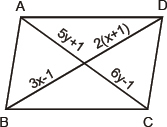Class 8th Mathematics
Class 8th Mathematics
Chapter 1 Rational Numbers
Chapter 2 Linear Equations in One Variable
Chapter 3 Understanding Quadilaterals
1. What should be added to -5/4 to get -1?
I. -1/4
II. 1/4
III. 1
IV. -3/4
I
II
III
IV
2. What should be subtracted from -5/4 to get -1?
I. -1/4
II. 1/4
III. 1
IV. -3/4
I
II
III
IV
3. Which of the following is the identity element?
I. 1
II. -1
III. 0
IV. None of these
I
II
III
IV
4. Which of the following lies between 0 and -1?
I. 0
II. -3
III. -2/3
IV. 4/3
I
II
III
IV
5. Which of the following is the product of 7/8 and -4/21?
I. -1/6
II. 1/12
III. -16/63
IV. -147/16
I
II
III
IV
6. Which of the following is the product of (-7/8) and 4/21?
I. -1/6
II. 12
III. -63/16
IV. -16/147
I
II
III
IV
7. Which of the following is the reciprocal of the reciprocal of a rational number?
I. -1
II. 1
III. 0
IV. The number itself
I
II
III
IV
8. If x is an even number, which is the next odd number?
I. X + 1
II. X + 2
III. X - 1
IV. X - 2
I
II
III
IV
9. If the sum of two consecutive number is 15 and greater of them is x then the smaller number is:
I. 16
II. 14
III. 8
IV. 7
I
II
III
IV
10. How old will I be after 10 years, if my age before 10 years was ‘x’ years?
I. X + 20
II. X - 20
III. X + 10
IV. X ‐ 10
I
II
III
IV
11. If 2x/5 = 4, the value of x is-
I. 10
II. -10
III. -8/5
IV. 8/5
I
II
III
IV
12. If the sum of two consecutive numbers is 71 and one number is x, then which equation is correct?
I. x + (x+1) = 71
II. x + (x+2) = 71
III. x + x = 71
IV. none of these
I
II
III
IV
13. If 7x+15 = 50, then which of the following is the root of the equation?
I. -5
II. 65/7
III. 5
IV. 1/5
I
II
III
IV
14. Two year ago my age was x years, then what was my age 5 years ago?
I. X + 7
II. X - 2 - 5
III. X - 5
IV. X- 3
I
II
III
IV
15. The sides of a pentagon are produced in order. Which of the following is the sum of its exterior angles?
(i) 540°
(ii) 180°
(iii) 720°
(iv) 360°
I
II
III
IV
16. The perimeter of a parallelogram is 150 cm. One of its side is greater than the other by 25 cm.
What is the length of smaller side of the parallelogram ?
I. 50 cm
II. 75 cm
III. 25 cm
IV. 60 cm
I
II
III
IV
17. If PQRS is a rhombus, the value of x and y

x = 60° , y = 70°
x = 50° , y = 40°
x = 80° , y = 60°
x = 100° , y = 50°
18. The value of y in the given parallelogram ABCD.
I. 70°
II. 60°
III. 50°
IV. 45°

I
II
III
IV
19. The length of diagonals AC and BD in the following figure where ABCD is a parallelogram.
I. AC = 22 and BD = 16
II. AC = 15 and BD = 15
III. AC = 17 and BD = 20
IV. AC = 20 and BD = 15

I
II
III
IV
20. State whether True or False.
All kites are rhombuses.
True
False

 mohsin khan
mohsin khan 